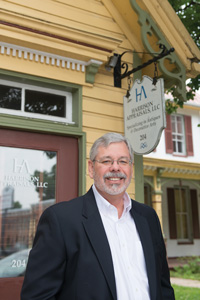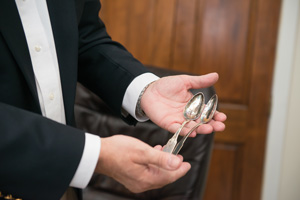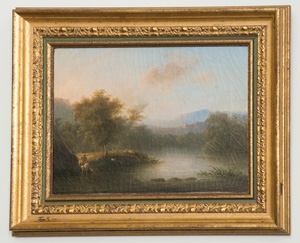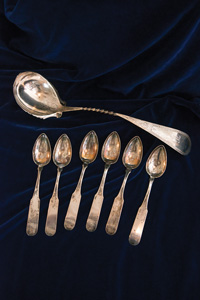Know If the Junk in Your Attic is a Valuable Antique
—With Robert Harrison ’80, history

1. Professional training
2. Research databases
3. Keen eyes and ears
4. A sense of history and context
Robert Harrison ’80, history, is fascinated by material culture. He was happily pursuing an academic career in history, he recalls, until “life intervened”
and forced a change in course.
“People were so much more intrigued by the material aspect over the cultural,” he explains. “Everyone kept asking me what things were worth. So I decided I better learn how to appraise.”
Harrison studied American decorative arts at the Museum for Early Southern Decorative Arts in North Carolina, and at the Winterthur Museum in Delaware. He underwent the International Society of Appraisers’ rigorous professional certification process.
He says he became “hooked on furniture forensics” – identifying and evaluating unsigned objects to determine their financial value. For the past 20 years, he has worked from his Westminster office, appraising items, providing expert witness testimony, and even appearing on television as a professional appraiser.
In short, Harrison knows if those items in your attic are run-of-the-mill or one-in-a-million. How can you tell?
Step 1: Decide Why You Want To Know
Assessing an object’s value can be a quick, easy, and even enjoyable, bit of sleuthing. It can also be arduous and time-consuming. What you want to do with the item determines the type of evaluation required. If it’s “keep” or “toss,” Google might do the trick. If a more official value is needed for insurance purposes, or dividing an estate fairly among heirs, more legwork is usually required.
Step 2: Take a Long, Slow Look
 Stand in front of the object. In good light, if possible. Take in its overall appearance. Note any manufacturer’s marks or stamps – usually on the back, the underside or the interior of an item. Take photos and measurements. Handle the object and observe its condition. Better condition equals higher value, but normal signs of “honest” wear are acceptable.
Stand in front of the object. In good light, if possible. Take in its overall appearance. Note any manufacturer’s marks or stamps – usually on the back, the underside or the interior of an item. Take photos and measurements. Handle the object and observe its condition. Better condition equals higher value, but normal signs of “honest” wear are acceptable.
Careful observation also identifies reproduction pieces made new to “look” old. These objects have “manufactured” wear that is out of sync with natural functionality, sometime even down to faux wormholes drilled into wood. For instance, single-slot screws are a good sign of authentic age. Uneven dovetail joints, too. Modern manufacture will have perfect joints cut by a machine. And, finally, take a good whiff. A reproduction smells newer.
Step 3: Consider the Source
Harrison says accurately appraising an object’s value is akin to telling its story. It is the detective work of finding where and when it was made, and hopefully by whom, as well as its history of ownership.
Anecdotal information is a good place to start. How did the object come into your possession? “If a client tells me, ‘My grandmother owned this and she was 100 when she died,’ I know we are looking at a potentially authentic and valuable piece,” says Harrison.
Step 4: Research, Research, Research
Appraising is more art than science, but it does need to be based on data. Harrison says that’s true even on antiques appraisal programs on public television. “On the TV shows,” he observes, “you don’t see the part where we are backstage on the computers, feverishly pulling comparables.”
Completed auctions on eBay can reveal the value of similar items. Auction house websites, such as Sotheby’s, are places where “recent sales will be well documented.” Books like Price it Yourself by Joe Rosson and Helaine Fendelman, or the popular Kovels’ Collectors Guides can also help. And don’t forget the proprietors of local antique shops and decorative arts galleries.
Step 5: Call in the Experts
 If preliminary research shows that the block-front corner cabinet you inherited from Great Aunt Harriet has potential value, it’s time to call a professional like Harrison.
If preliminary research shows that the block-front corner cabinet you inherited from Great Aunt Harriet has potential value, it’s time to call a professional like Harrison.
Formal appraisals also are essential when making a charitable donation or insuring very valuable objects.
Professional appraisers provide a written report that includes a full description of your item and the procedure used to estimate its current value. The American Society of Appraisers has a website, searchable by both location and specialty, to find certified professionals.
“People think an object’s great age automatically confers value, but sometimes old is just old, and there isn’t much there money-wise,” Harrison explains. “But worth is relative. If a piece came down through your family and stirs memories every time you look at it, that means it is valuable – to you.”
— Michelle Gienow
By the Numbers
 Number of years in business: 23
Number of years in business: 23
Largest number of objects appraised on a single assignment: 9,000
Largest number of hours devoted to a single appraisal: 800
Most valuable object appraised in the last 6 months:
$5 million
Number of times we’ve heard “This was owned by my grandmother who was more than 90 years old when she died”: Too many.

